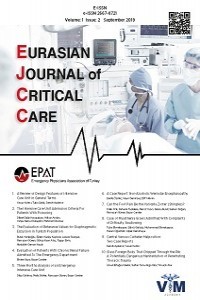INVESTIGATION OF EOSINOPHIL, LYMPHOCYTE AND MONOCYTE VALUES ACCORDING TO AGE AND GENDER IN INSECT BITES IN THE EMERGENCY DEPARTMENT
INVESTIGATION OF EOSINOPHIL, LYMPHOCYTE AND MONOCYTE VALUES ACCORDING TO AGE AND GENDER IN INSECT BITES IN THE EMERGENCY DEPARTMENT
___
- 1. Söyük S, KURTULUŞ SA. Acil servislerde yaşanan sorunların çalışanlar gözünden değerlendirilmesi. Gümüşhane Üniversitesi Sağlık Bilimleri Dergisi. 2017;6(4):44-56.
- 2. Altıntop I, Tatlı M. Acil servis yoğunluğuna farklı bir bakış: anket çalışması. Journal of Anatolian Medical Research. 2017;2(1):45-57.
- 3. Organization WH. Declaration of alma-ata. World Health Organization. Regional Office for Europe; 1978.
- 4. Başer DA, Kahveci R, Meltem K, KASIM İ, Şencan İ, Özkara A. Etkin sağlık sistemleri için güçlü birinci basamak. Ankara Medical Journal. 2015;15(1).
- 5. Macinko J, Starfield B, Shi L. The contribution of primary care systems to health outcomes within Organization for Economic Cooperation and Development (OECD) countries, 1970–1998. Health services research. 2003;38(3):831-65.
- 6. Gulliford MC, Jack RH, Adams G, Ukoumunne OC. Availability and structure of primary medical care services and population health and health care indicators in England. BMC Health Services Research. 2004;4(1):1-8.
- 7. Schäfer WL, Boerma WG, Kringos DS, De Maeseneer J, Gress S, Heinemann S, et al. QUALICOPC, a multi-country study evaluating quality, costs and equity in primary care. BMC Fam Pract. 2011;12:115.
- 8. Parchman ML, Culler S. Primary care physicians and avoidable hospitalizations. J Fam Pract. 1994;39(2):123-8.
- 9. Zengin N. “SAĞLIK HAKKI” ve SAĞLIK HİZMETLERİNİN SUNUMU. Sağlıkta Performans ve Kalite Dergisi. 2010;1(1):44-52.
- 10. Başol E. GELİŞMEKTE OLAN ÜLKELERDE STRATEJİ: SAĞLIK SİSTEMİNDE SEVK ZİNCİRİ. Balkan Sosyal Bilimler Dergisi. 2015;4(8):128-40.
- 11. Çınar O, Çevik E, Salman N, Cömert B. Emergency severity index triaj sistemi ve bir üniversite hastanesi acil servisinde uygulama deneyimi. Türkiye Acil Tıp Dergisi. 2010;10(3):126-31.
- 12. Eitel DR, Travers DA, Rosenau AM, Gilboy N, Wuerz RC. The emergency severity index triage algorithm version 2 is reliable and valid. Acad Emerg Med. 2003;10(10):1070-80.
- 13. Tanabe P, Gimbel R, Yarnold PR, Kyriacou DN, Adams JG. Reliability and validity of scores on The Emergency Severity Index version 3. Acad Emerg Med. 2004;11(1):59-65.
- 14. Pereira S, Oliveira e Silva A, Quintas M, Almeida J, Marujo C, Pizarro M, et al. Appropriateness of emergency department visits in a Portuguese university hospital. Ann Emerg Med. 2001;37(6):580-6.
- 15. Carret ML, Fassa AG, Kawachi I. Demand for emergency health service: factors associated with inappropriate use. BMC Health Serv Res. 2007;7:131.
- 16. Miyazawa A, Maeno T, Shaku F, Tsutsumi M, Kurihara H, Takayashiki A, et al. Inappropriate use of the emergency department for nonurgent conditions: Patient characteristics and associated factors at a Japanese hospital. J Gen Fam Med. 2019;20(4):146-53.
- 17. Idil H, Kilic TY, Toker İ, Dura Turan K, Yesilaras M. Non-urgent adult patients in the emergency department: Causes and patient characteristics. Turk J Emerg Med. 2018;18(2):71-4.
- 18. Sempere-Selva T, Peiró S, Sendra-Pina P, Martínez-Espín C, López-Aguilera I. Inappropriate use of an accident and emergency department: magnitude, associated factors, and reasons--an approach with explicit criteria. Ann Emerg Med. 2001;37(6):568-79.
- 19. Almeida A, Vales J. The impact of primary health care reform on hospital emergency department overcrowding: Evidence from the Portuguese reform. Int J Health Plann Manage. 2020;35(1):368-77.
- Başlangıç: 2019
- Yayıncı: Acil Tıp Uzmanları Derneği
Successful treatment of warfarin overdose with 20% lipid solution: a case report
Damla ERNUR, Bülent Serhan YURTLU, Volkan HANCI
Tracheostomy complications in children: Single center experience
Ulaş GÜVENÇ, Nazan TAŞLIDERE, Didem DİZMAN
Muhammed Semih GEDİK, Muhammed ÇİFTÇİOĞLU
Mustafa Enes DEMİREL, Ufuk Turan Kürşat KORMAZ, Ömer ÇETİN, Hatice GÜLDAL, Mustafa BOĞAN
A Case Report of Kounis Syndrome Developing Anaphylaxis Secondary to Vitamin B and C Infusion
İbrahim TANRIÖĞEN, Didar Elif AKGÜN, Özgen ŞAFAK
The New Biomarkers for Acute Coronary Syndrome
